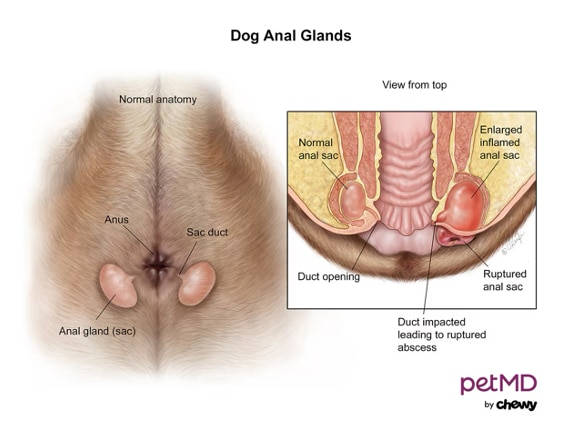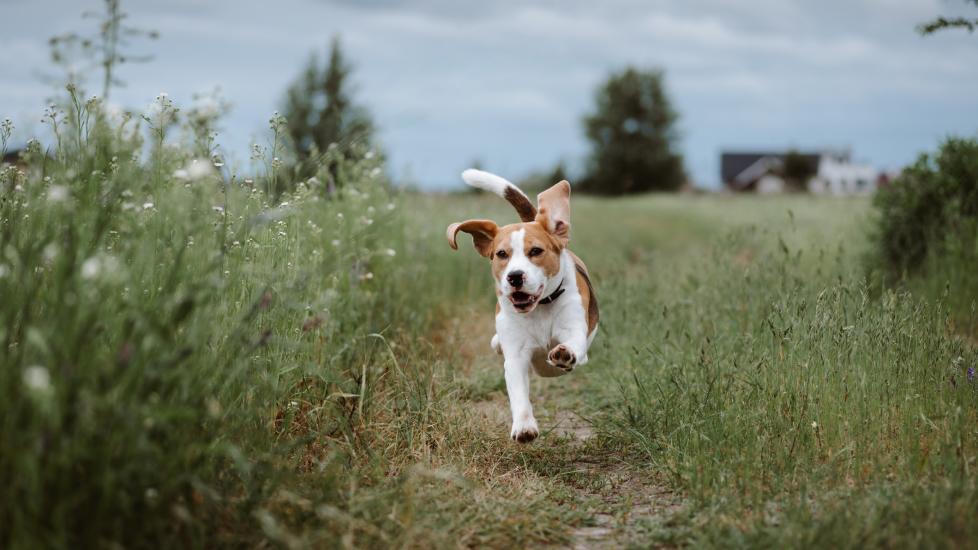Dog Anal Glands: Common Problems and How To Perform Anal Gland Expression
Tetiana Garkusha/iStock / Getty Images Plus via Getty Images
Most dogs go their whole life without any concerns with their anal glands.
Normally, when dogs have a bowel movement, it expresses their glands naturally, releasing anal gland fluid. Dogs may also involuntarily express their own anal glands when they are scared or stressed.
Expressing their own anal glands allows a dog to leave their scent behind to claim their territory near their home or in their yard during a normal bowel movement.
When dogs meet, they sniff each other’s hind ends and anal glands to gather information about the other dog’s hormonal status.
When dogs have a bowel movement, it expresses their glands naturally, releasing anal gland fluid.
Dog anal glands can become full, impacted, or infected. Impacted or diseased dog anal glands can be painful, so it’s important to recognize the signs of an issue and know what to do when it happens.
In this article, you'll learn about anal glands on dogs—including how they work, anal gland expression, signs of anal sac disease, and when to take your dog to the vet for anal gland issues.
Health Tools
Not sure whether to see a vet?
What Are Dog Anal Glands?
Dog anal glands are two small pockets—each about the size of a pea—located on the right and left side of a dog’s anus. Each gland connects to a small tube that secretes a distinctive, foul-smelling fluid.

Under normal circumstances, when stool passes through the anus, it applies pressure to the glands and releases (expresses) the fluid.
Both male and female dogs—as well as cats and other animals—have anal glands. These glands are not essential to your dog’s health, and they can live without them if they need to be removed for medical reasons.
Types of Dog Anal Gland Problems
Anal sac disease in dogs is a broad term that includes a few specific conditions.
These include:
-
Anal gland impaction—Impacted anal glands will cause moderate pain in dogs.
-
When the anal gland fluid thickens, this pasty, brown material clogs the sac and creates a hard mass. In average cases of impaction, the anal glands can be expressed with significant pressure.
-
-
Anal gland infection or abscess—A dog suffering from an anal gland infection or abscess will be in moderate to severe pain.
-
If the gland is infected, bacteria from the infection cause pus to build up inside the gland. An infection can then progress to an abscess when the pus-filled sac and swollen tissue cause the gland opening to be obstructed.
-
You may see discoloration around the anal area or a red, hot, swollen spot on the hind end, typically next to or inside the anal opening.
-
-
-
Ruptured anal gland abscess—If an abscess is left untreated, it can rupture, and your dog will be in severe to extreme pain.
-
The ruptures (fistulas) lead from the anal gland through the skin. You may see a greenish yellow or bloody pus coming from the ruptured gland.
-
-
Anal gland cancer—The anal glands may also be the site of cancerous tumors. The most common type of anal gland cancer is known as apocrine gland anal sac adenocarcinoma (AGASACA).
-
This condition may not cause your dog any pain. It’s more common in older, female dogs. Certain breeds such as German Shepherds and Dachshunds are at higher risk.
-
Signs of Dog Anal Gland Problems
The most common signs of dog anal gland issues include:
-
Frequently turning to lick or bite their hind end
-
Straining to poop
-
Showing discomfort when pooping (dyschezia)
-
Not wanting to sit
-
Discharge from around the anus
-
A frequent fishy odor
Dogs with anal gland problems might also have the following signs:
-
Crying or whimpering
-
Becoming withdrawn or lethargic
-
Swelling or redness in the anal area
If these symptoms persist or affect your dog’s behavior, you should contact your veterinarian.
If left untreated, anal gland impactions, infections, and abscesses can become major issues.
Dog anal gland problems are predominantly a small dog breed issue, but they can affect larger breed dogs as well.
Dogs that may be more at risk of anal gland conditions include:
Other factors that may increase the chances of dog anal gland issues include:
-
Chronic skin conditions (seborrhea, skin infections, or itchy skin)
-
Change in stool consistency (soft stool, diarrhea, or constipation)
-
Parasites (both internal and external)
-
Food and/or environmental allergies
-
Genetics (more common in small breeds)
How To Tell If a Dog’s Anal Glands Are Full
Most dogs involuntarily express their anal glands. If a dog’s nutritional needs are being met with high-quality food, and they maintain a healthy weight and get plenty of exercise, they should not need to have their anal glands expressed. If your dog is not having an issue, there is nothing you need to do.
Check with your vet if you are wanting to do routine expression. Your vet may recommend leaving the anal glands alone if they are not causing a problem, or they may agree to routinely express them to avoid a medical issue.
Some dogs, however, require their glands to be manually expressed.
If the consistency of your dog’s stool changes, their anal glands may not be naturally expressed on their own.
The liquid in the glands will thicken over time, making it harder to be able to express. If this happens, the glands can become irritated, inflamed, impacted, and even infected.
Once your dog starts to have symptoms and issues with their anal glands, it's best to have their glands expressed every three to four weeks to prevent the issue from happening again.
Your dog’s anal glands can be expressed by your veterinarian, a veterinary technician, or even some dog groomers.
How To Perform Dog Anal Gland Expression
If your vet has agreed that your dog requires their anal glands to be expressed routinely, they might instruct you to perform the anal gland expression at home if you’re comfortable. Make sure that you are confident that your dog won’t be reactive to having their anal glands expressed.
If you see blood or pus around your dog’s anus, or if your dog seems uncomfortable, don’t attempt to express their anal glands at home. Instead, make an appointment with your veterinarian immediately.
To express your dog’s anal glands at home, you need:
-
Latex gloves
-
Petroleum or a water-based lubricant
-
Another person to help hold your pup
Follow these steps to perform dog anal gland expression:
-
If your dog is small, place them on a table or counter in front of you. If you have a large dog, you can kneel behind them.
-
Have another person hold your dog by placing one arm underneath and around their neck, and the other arm around the rest of your dog’s body, hugging them close.
-
Put on a pair of latex or similar gloves and lubricate your index finger with petroleum jelly or a water-based lubricant.
-
Lift your dog’s tail and gently insert your index finger into the rectum approximately 1 inch.
-
Feel with your index finger and thumb for a firm pea- or marble-sized object at the 5 or 7 o’clock positions.
-
When you have found one gland, place a paper towel between the dog’s anus and your hand and gently milk the gland’s contents outward by applying pressure on the farthest side of the gland and squeezing toward you. Do not use more pressure than you would feel comfortable applying if you were pressing on your eyes, for example.
-
You should barely be able to feel the gland when it’s empty.
-
Wipe the anal area clean.
-
Repeat on the other side for the other gland.
Treatment for Dog Anal Gland Problems
These conditions should be diagnosed by your veterinarian after a complete physical examination, including a digital rectal exam.
Most cases of anal sac disease in dogs can be treated with manual anal gland expression and local treatment with antibiotics and/or steroid ointments.
Additional testing may needed to create a specific treatment plan for your dog. Tests may include:
-
Bacterial culture and sensitivity
Most cases of anal sac disease in dogs can be treated with manual anal gland expression and local treatment with antibiotics and/or steroid ointments.
Some cases will require oral antibiotics, such as clindamycin, and anti-inflammatory pain medication, such as carprofen. In severe cases, surgical intervention might be needed.
For anal gland cancer, your vet will need to determine if it has spread to the lymph nodes or other areas, such as the lungs, liver, or spleen.
You will need to consult a veterinary oncologist, and the treatment might include removal of the anal gland and sac, chemotherapy, or radiation.
How To Prevent Anal Gland Issues in Dogs
Eating a diet with adequate fiber can help keep your dog’s anal glands healthy. Fiber promotes healthy digestion and proper stool formation. The force of the firm, bulky stool against the colon wall near the anus can help express the anal glands during bowel movements.
Keeping your dog at a healthy weight can also contribute to healthy anal glands.
Overweight dogs tend to accumulate excess fluid in their anal glands because their body fat reduces the pressure on the sacs during pooping.
If your dog is overweight, speak with your veterinarian about a weight-loss plan. A combination of diet and exercise will help your dog reach and maintain a healthy weight.
Discuss the options with your veterinarian before you make any diet changes for your dog.
You can also add dietary fiber to your dog’s diet and reduce the risk of anal sac disease with dietary supplements. Omega-3 fatty acids and fish oil supplements have natural anti-inflammatory properties and may help reduce irritation around an affected anal gland. Probiotics formulated with fiber also help promote intestinal health.
A few recommended supplements include:
Dog Anal Glands FAQs
What happens if a dog’s anal glands aren’t expressed?
Most dogs express their anal sacs on their own they defecate, but if your dog can’t express their own anal sacs, they can become impacted and infected. This may lead to painful abscesses.
Can I empty my dog’s anal glands myself?
You can empty your dog’s anal glands on your own so long as they aren’t infected or impacted. However, check with your veterinarian first.
If your dog is expressing their anal sacs on their own, you don’t need to perform anal sac expression. Your veterinarian can show you how to express dog anal sacs.
Can food cause anal gland issues in dogs?
Food is most likely to cause anal gland issues in dogs who have food allergies. The resulting skin inflammation can cause anal sac problems. High fiber diets are also beneficial for anal sac health.
